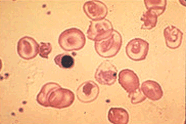The b -globin gene family
and b -thalessemia
Sickle cell anemia is not the only disease caused by a mutation in the b -globin gene. A second disease known as beta-thalessemia occurs as a result of several mutations in the b -globin gene and ultimately leads to abrogated production of the b -globin protein. There are over 500 b -thalessemia causing mutations that have been identified. These mutations do not affect the structure of hemoglobin so sickled blood cells are not present; instead, suffers of b -thalessemia lack functional hemoglobin.

Figure 1: Red blood cells with beta-thalessemia lack functional hemoglobin appearing paler and more vacuous.
The symptoms of this disease vary greatly depending on the amount of functional hemoglobin that is produced. People with mild cases of b -thalessemia often display no symptoms and are never diagnosed with the disease. On the other hand, those with severe cases require constant blood tranfusions beginning at age one to two months to supply them with functional hemoglobin required to carry oxygen throughout the body.
